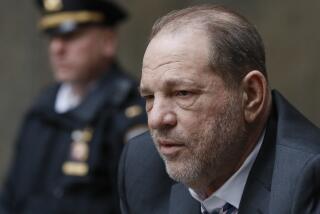Kennedy cousin Michael Skakel wins at Connecticut Supreme Court, conviction vacated in 1975 slaying of Martha Moxley
- Share via
In a decision certain to start new debate about a notorious, old crime, a divided state Supreme Court abruptly reversed itself Friday, overturning Kennedy cousin Michael Skakel’s conviction for the murder of his friend Martha Moxley a half century ago, when the two were 15-year-old neighbors in an exclusive Greenwich, Conn., community.
Acting on Skakel’s request that it reconsider an earlier decision against him, the court ruled 4-3 that Skakel’s trial lawyer was so ineffective that his right to a fair trial was violated. Remarkably, just 16 months ago, the court took the opposite position. In that 4-3 decision the court concluded on the same facts that Skakel’s criminal defense was competent, that his conviction should stand and that he should finish serving his life sentence.
Friday’s ruling means that, 43 years after Moxley was beaten to death with a golf club and 15 years after a jury convicted Skakel of murder, the charge is vacated. Skakel has been free since late 2013 while the court considered this latest appeal. He is expected to remain free unless state prosecutors make what many lawyers predict would be an unlikely decision to retry him on decades-old evidence.
The decision is a rare about-face for the court. Parties who lose cases usually ask the court to reconsider and the court usually declines, within weeks. What changed between the decisions against Skakel in December 2016 and in his favor Friday was its composition. Justice Peter T. Zarella resigned after writing the earlier, majority decision upholding Skakel’s conviction and was replaced by Justice Gregory T. D’Auria, who became part of the new majority Friday.
Friday’s decision has been a subject of hot speculation among lawyers for months and comes at a time when the Legislature is being more assertive in the appointment of judges. It could turn attention to the court itself and away from what always have been the case’s attractions: the Kennedy family — Skakel’s father was Ethel Kennedy’s brother — and glimpses of life among the very well-heeled in Greenwich.
Writing for Friday’s majority, Justice Richard N. Palmer concluded that the defense of Skakel mounted by Greenwich celebrity attorney Michael Sherman — he represented Skakel through investigation, trial and conviction in 2002 — was so far beneath the accepted standard of professional competence that the jury’s guilty verdict cannot be relied upon. The majority affirmed a a lower court decision in a habeas corpus action five years ago.
“The sole issue now before us in this appeal by the respondent, the Commissioner of Correction, is whether the habeas court properly concluded that the petitioner, Michael Skakel, is entitled to a new trial because counsel in his murder case, Michael Sherman, rendered ineffective assistance by failing to obtain certain readily available evidence that Sherman should have known was potentially critical to the petitioner’s alibi defense, that is, the testimony of a disinterested alibi witness whom the habeas court found to be highly credible,” the majority wrote. “Because we agree with the habeas court both that Sherman’s failure to secure that evidence was constitutionally inexcusable and that that deficiency undermines confidence in the reliability of the petitioner’s conviction — a conviction founded on a case, aptly characterized by the habeas court as far from overwhelming, that was devoid of any forensic evidence or eyewitness testimony linking the petitioner to the crime — we affirm the judgment of the habeas court ordering a new trial.”
Skakel’s lawyers, Hubert Santos and Trent LaLima, released a brief statement in which they praised Superior Court Judge Thomas A. Bishop, who wrote the habeas decision.
“The decision by Judge Bishop is one of the great habeas decisions issued in the history of Connecticut jurisprudence,” the statement said.
State prosecutors could ask the U.S. Supreme Court to review Friday’s decision, but a spokesman said Friday, “We are reviewing the court’s opinions and have no comment at this time.”
Dorothy Moxley, the victim’s mother, said she was shocked by the decision and, when she turns 86 next month, will have spent half her life waiting for justice for her daughter. She said she is confident Skakel is guilty.
“I really thought he would go back to jail because it seemed so simple, so obvious to me,” Moxley said Friday, in her New Jersey apartment. “I have no doubts at all that Michael Skakel is the one who murdered my daughter.”
Sherman’s defense has been criticized for a multitude of deficiencies. The decision Friday turned on one.
Sherman was aware of, but ignored, a credible witness, Denis Ossorfio, who would have confirmed Skakel’s alibi if called to testify. Skakel has claimed since his first interview with police in 1975 that, close to the time Moxley is believed to have been killed, he and two of his brothers were 20 minutes away in what is known as the Greenwich back country, watching “Monty Python’s Flying Circus” on television with a cousin in the cousin’s home.
Had the jury heard Ossorio, who — unlike Skakel’s brothers and cousin — had no ties to the Skakel family and could not be accused of bias, the verdict might have been not guilty, the court said.
Palmer and D’Auria were joined in the majority by justices Andrew J. McDonald and Richard A. Robinson, who was confirmed this week as the court’s new chief justice.
Palmer took the same position 15 months ago, but it was in a dissent as a member of the minority. In the earlier decision, Zarella wrote for the majority that Sherman’s defense of Skakel was competent and based on sound tactical decisions. Those taking the minority view, Zarella wrote, were engaged in impermissible second-guessing, years after the events.
This time around, Justices Dennis G. Eveleigh, Christine S. Vertefeuille and Carmen E. Espinosa were in the minority. Eveleigh produced a written dissent for himself, Espinosa and Vertefeuille.
“I continue to believe that the performance of defense counsel, Michael Sherman,was not deficient and, therefore, that the petitioner, Michael Skakel, was not denied his constitutional right to the effective assistance of counsel,” Eveleigh wrote. “Moreover, even if defense counsel’s performance in failing to identify one additional alibi witness, Denis Ossorio, was so deficient as to warrant reconsideration of that decision, I am not persuaded that this alleged shortcoming prejudiced the defense.”
Eveleigh said that Ossorio, in his view, may not have covered Skakel for the entire window of a time in which experts believed Moxley may have been killed, and he accused the majority of twisting facts to suit to suit its purposes.
“Although it recognizes that we are required to engage in a comprehensive, objective review of the factual record, the majority repeatedly minimizes or overlooks evidence and inferences that fail to comport with its narrative of the case, while exaggerating or overstating the strength of the petitioner’s arguments,” Eveleigh wrote. “Barely acknowledging that the state’s evidence was sufficiently compelling to persuade twelve jurors beyond a reasonable doubt of the petitioner’s guilt, the majority takes it upon itself to make credibility determinations with regard to trial witnesses whose testimony bore no direct relationship to the alleged deficient performance of defense counsel. Perhaps most worrisome, the majority refers throughout its opinion to evidence from outside of the trial record, much of which is not even arguably a proper subject of judicial notice.”
Espinosa, pressing the limits of collegiality among justices, wrote a highly critical dissent to, in her own words, “highlight the continued and disturbing practice … of certain justices of this court ignoring the law and fabricating facts in order to reach their desired result.”
“There are thousands of convicted criminals languishing in Connecticut’s prisons, approximately two-thirds of whom are either African American or Hispanic, who would undoubtedly be thrilled to receive such special treatment. … Unfortunately for them, the vast majority do not share the petitioner’s financial resources, social standing, ethnicity or connections to a political dynasty,” wrote Espinosa, a former prosecutor who is scheduled to retire this month.
Friday’s decision was based on a habeas corpus petition in which Skakel’s new attorney, Hubert J. Santos, argued that Sherman’s defense was egregiously incompetent. Superior Court Judge Thomas A. Bishop heard the habeas case and agreed, concluding in an exhaustive written opinion that Sherman’s defense “was in a myriad of ways ineffective.”
Bishop identified 10 deficiencies. Among those, he said three were serious enough to undermine the verdict and require a new trial. One of the three, Bishop said, was Sherman’s failure to locate and call the alibi witness — in spite of being alerted to the witness through grand jury transcripts provided by the prosecution.
The state appealed Bishop’s ruling and won 4-3 with the Zarella-led majority in December 2016. Santos asked for reconsideration, but asked the court to wait until Gov. Dannell Malloy replaced Zarella, who retired the day his decision was published. Without a replacement, reconsideration would have likely failed in a 3-3 tie. Santos also asked for reconsideration solely on the issue of Sherman’s failure to locate the alibi witness.
The witness is Dennis Ossorio. In 1975, Ossorio was involved personally with Skakel cousin Georgeann Dowdle and on the evening of the murder he was visiting at her country home — the home 20 minutes from Belle Haven where Skakel insists he was watching Monty Python with two brothers and his cousin James Dowdle, Georgeann’s brother, close to the time expert believe Moxley was killed.
When Santos called Ossorio to testify at the habeas trial, Ossorio corroborated Skakel’s alibi. He said he saw Skakel, two of his brothers and their cousin James Dowdle watching Monty Python. He testified that he chatted with them and watched part of the show with them. If Sherman had called him as a defense witness, Ossorio said he would have testified the same way at the criminal trial.
Sherman, also testifying at the habeas trial, said he was unaware of Ossorio until informed just days before the habeas trial in the spring of 2013.
“I still don’t know who he is,” Sherman testified.
Bishop concluded in his habeas decision that Sherman could have — and should have — found Ossorio years before the criminal trial by reading, as Sherman insists he did, Georgeann Dowdle’s 1998 testimony to the grand jury investigating Moxley’s death.
Georgeann Dowdle told the grand jury that, on the night of the murder, she was caring for a child in a room separate from where Monty Python was playing on the television. She said she could not see who was watching television, but recognized the voices of some of her Skakel cousins. She said she was uncertain whether one of the voices belonged to Skakel.
When asked by the grand jury whether she saw her brother James among the television watchers, she said she was unsure and, in the same response, referred obliquely to her “beau,” whom Santos identified as Ossorio.
“I was in my mother’s library which is off the living room,” she told the grand jury, “and I was in there with my beau at the time and I didn’t really venture out.”
Sherman testified at the habeas trial that Skakel’s alibi was “the mainframe” of his defense. But he said Skakel, his brothers and their cousin James failed to mention Ossorio’s presence at the Dowdle house, in spite of his repeated inquiries about potential witnesses. He said he did not pursue Ossorio’s identify through other means — such as asking Georgeann Dowdle who her beau was — because the grand jury transcript suggested Ossorio too remained in a separate room with Georgeann and didn’t see which Skakel cousins were watching Monty Python.
The Supreme court, in its 2016 decision, concluded that Sherman’s explanation were reasonable.
Skakel’s trial turned on the alibi.
The night Moxley was killed — forensic and other evidence suggest it was between 9:30 and 10 p.m. on Oct. 30, 1975 — she and some friends were wandering around Belle Haven during the early part of the evening. It was mischief night, the night before Halloween.
Skakel, some of his brothers, his sister, cousin James Dowdle and a friend — all supervised by the Skakel tutor — dined that night at the Belle Haven Club. Returning home at around 9 p.m., Skakel met Moxley and some other teens. He said he and Moxley, his brother Thomas and two other children climbed into his father’s Lincoln and listened to the radio in the Skakel driveway.
At about 9:30 p.m., no one disputes that two of Skakel’s older brothers and James Dowdle appeared. They ordered the younger children out of the Lincoln. They needed the car to drive Dowdle across town to his home, where they planned to watch Monty Python.
What happened next has been disputed for decades. Skakel claims he got back into the car and drove off with his older brother and James Dowdle. He contends he could not have killed Moxley because he left before she did and he did not return home until 11 p.m. or so, after what some experts believe was the mostly like time of death.
Dowdle and his brothers supported the alibi at his trial. But other children can’t remember whether he drove off in the Lincoln or they recall that he stayed behind.
The prosecution tried to discredit Dowdle and the brothers at the trial, arguing that they lied as part of a Skakel family conspiracy to prevent his conviction.
In his decision, Bishop called Ossorio “a disinterested and credible witness” and a “powerful witness in support of petitioner’s alibi claim.”
More to Read
Sign up for Essential California
The most important California stories and recommendations in your inbox every morning.
You may occasionally receive promotional content from the Los Angeles Times.











